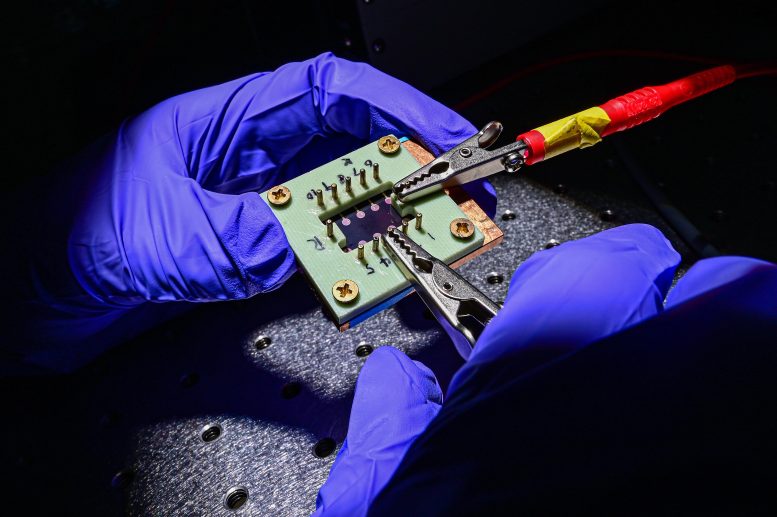
Rice University graduate student Wenbin Li prepares a 2D perovskite solar cell for testing in a solar simulator. Rice engineers boosted the efficiency of cells made of two-dimensional perovskites while retaining their toughness. Credit: Jeff Fitlow/Rice University
Using the Advanced Photon Source’s ultrabright X-rays, researchers have determined that sunlight itself can improve the efficiency of 2D materials used to collect solar energy.
A team of researchers led by Rice University has achieved a new benchmark in the design of atomically thin solar cells made of semiconducting perovskites, boosting their efficiency while retaining their ability to stand up to the environment.
Rice’s Aditya Mohite and his colleagues discovered that sunlight itself contracts the space between atomic layers in 2D perovskites enough to improve the material’s photovoltaic efficiency by up to 18%, an astounding leap in a field where progress is often measured in fractions of a percent.
“In 10 years, the efficiencies of perovskites have skyrocketed from about 3% to over 25%,” Mohite said. “Other semiconductors have taken about 60 years to get there. That’s why we’re so excited.”
“The same way your mechanic wants to run your engine to see what’s happening inside it, we want to essentially take a video of this transformation instead of a single snapshot. Facilities such as the APS allow us to do that.” — Joe Strzalka, Argonne National Laboratory
The team used the resources of the Advanced Photon Source (APS), a U.S. Department of Energy (DOE) Office of Science user facility at DOE’s Argonne National Laboratory, to confirm the discovery. The research was recently published in Nature Nanotechnology.
Perovskites are compounds that have cubelike crystal lattices and are highly efficient light harvesters. Their potential has been known for years, but they present a conundrum: They’re good at converting sunlight into energy, but sunlight and moisture degrade them.
“A solar cell technology is expected to work for 20 to 25 years,” said Mohite. “We’ve been working for many years and continue to work with bulk perovskites that are very efficient but not as stable. In contrast, 2D perovskites have tremendous stability but are not efficient enough to put on a roof. The big issue has been to make them efficient without compromising the stability.”
The Rice engineers and their collaborators at Purdue and Northwestern universities; DOE national laboratories Los Alamos, Argonne and Brookhaven; and the Institute of Electronics and Digital Technologies (INSA) in Rennes, France, discovered that in certain 2D perovskites, sunlight effectively shrinks the space between the atoms, improving their ability to carry a current.
“We find that as you light the material, you kind of squeeze it like a sponge and bring the layers together to enhance the charge transport in that direction,” Mohite said. The researchers found placing a layer of organic positive ions between the iodide on top and lead on the bottom enhanced interactions between the layers.
“This work has significant implications for studying excited states and quasiparticles in which a positive charge lies on one layer and the negative charge lies on the other and they can talk to each other,” Mohite said. “These are called excitons, which may have unique properties.”
To observe the material contraction in action, the team made use of two DOE Office of Science user facilities: the National Synchrotron Light Source II at DOE’s Brookhaven National Laboratory and the APS.
Argonne physicist Joe Strzalka, a co-author on the paper, used the ultrabright X-rays of the APS to capture minuscule structural changes in the material in real time. The sensitive instruments at beamline 8-ID-E of the APS allow for “operando” studies, meaning those conducted while the device is undergoing controlled changes in temperature or environment under normal operating conditions. In this case, Strzalka and his colleagues exposed the photoactive material from the solar cell to simulated sunlight while keeping the temperature constant, and observed tiny contractions at the atomic level.
As a control experiment, Strzalka and his co-authors also kept the room dark and raised the temperature, observing the opposite effect — an expansion of the material. This showed that it was the light itself, not the heat it generated, that caused the transformation.
“For changes like this, it’s important to do operando studies,” Strzalka said. “The same way your mechanic wants to run your engine to see what’s happening inside it, we want to essentially take a video of this transformation instead of a single snapshot. Facilities such as the APS allow us to do that.”
Experiments were confirmed by computer models by colleagues in France. “This study offered a unique opportunity to combine state of the art simulation techniques, material investigations using large scale national synchrotron facilities and in-situ characterizations of solar cells under operation,” said Jacky Even, a professor of physics at the Institut National des Sciences Appliquées. “The paper depicts for the first time how a percolation phenomenon suddenly releases the charge current flow in a perovskite material.”
Both results showed that after 10 minutes under a solar simulator at one sun intensity, the 2D perovskites contracted by 0.4% along their length and about 1% top to bottom. They demonstrated the effect can be seen in one minute under five sun intensity.
“It doesn’t sound like a lot, but this 1% contraction in the lattice spacing induces a large enhancement of electron flow,” said Rice graduate student and co-lead author Wenbin Li. “Our research shows a threefold increase in the electron conduction of the material.”
At the same time, the nature of the lattice made the material less prone to degrading, even when heated to 80 degrees